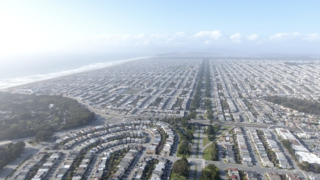
The Sunset District is a neighborhood located in the southwest quadrant of San Francisco, California, United States.
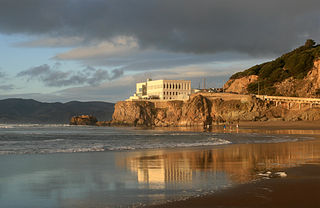
Ocean Beach is a beach on the west coast of San Francisco, California, United States, bordering the Pacific Ocean. It is adjacent to Golden Gate Park, the Richmond District, and the Sunset District. The Great Highway runs alongside the beach, and the Cliff House and the site of the former Sutro Baths sit at the northern end. The beach is a part of the Golden Gate National Recreation Area, which is administered by the National Park Service. It is accessible via Muni Metro at the Judah and La Playa station.

The Panhandle is a public park in San Francisco, California, so named because it forms a panhandle with Golden Gate Park. It is long and narrow, being three-quarters of a mile long and just one block wide. Fell and Oak Streets border it to the north and south, Baker Street to the east, and to the west Stanyan Street which separates the smaller Panhandle from the much larger Golden Gate Park. The Panhandle is bisected by Masonic Avenue, which runs north to south and cuts through the middle of the park. In its westernmost block, Oak and Fell Streets angle across the Panhandle, converge with one another, and continue west of Stanyan as John F. Kennedy Drive and Kezar Drive.
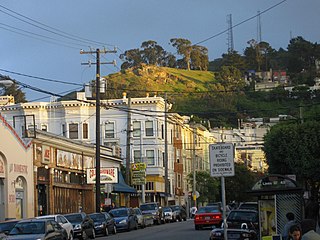
Cole Valley is a small neighborhood in San Francisco, California. It borders Golden Gate Park to the north, Haight-Ashbury to the northeast, The Castro to the east. and Twin Peaks to the south. Near Kezar Stadium, Cole Valley is the smallest neighborhood in the city.
Rancho San Antonio, also known as the Peralta Grant, was a 44,800-acre (181 km2) land grant by Governor Pablo Vicente de Solá, the last Spanish governor of California, to Don Luís María Peralta, a sergeant in the Spanish Army and later, commissioner of the Pueblo of San José, in recognition of his forty years of service. The grant, issued on August 3, 1820, embraced the sites of the cities of San Leandro, Oakland, Alameda, Emeryville, Piedmont, Berkeley, and Albany.

The Port of San Francisco is a semi-independent organization that oversees the port facilities at San Francisco, California, United States. It is run by a five-member commission, appointed by the Mayor and approved by the Board of Supervisors. The Port is responsible for managing the larger waterfront area that extends from the anchorage of the Golden Gate Bridge, along the Marina district, all the way around the north and east shores of the city of San Francisco including Fisherman's Wharf and the Embarcadero, and southward to the city line just beyond Candlestick Point. In 1968, the State of California, via the California State Lands Commission for the State-operated San Francisco Port Authority, transferred its responsibilities for the Harbor of San Francisco waterfront to the City and County of San Francisco / San Francisco Harbor Commission through the Burton Act AB2649. All eligible State port authority employees had the option to become employees of the City and County of San Francisco to maintain consistent operation of the Port of San Francisco.

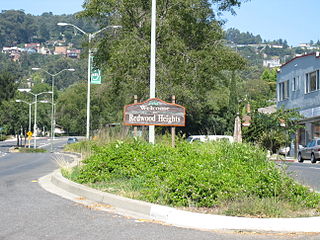


Henry Perrin Coon was the 10th Mayor of San Francisco who served from July 1, 1863, to December 1, 1867. He was one of the most versatile men ever to hold the office, having previously worked as a teacher, doctor, lawyer, druggist and businessman.
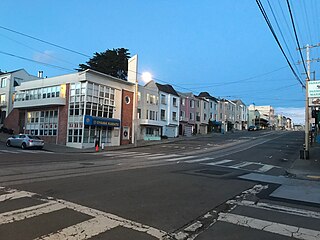
The Parkside is a neighborhood in the western part of San Francisco, California, usually considered to be part of the Sunset District. It is located in the southern part of the Avenues south of Quintara and north of Sloat Boulevard.
The California Land Act of 1851, enacted following the Treaty of Guadalupe Hidalgo and the admission of California as a state in 1850, established a three-member Public Land Commission to determine the validity of prior Spanish and Mexican land grants. It required landowners who claimed title under the Mexican government to file their claim with a commission within two years. Contrary to the Treaty of Guadalupe Hidalgo, which guaranteed full protection of all property rights for Mexican citizens, it placed the burden on landholders to prove their title.

Carville, also known as Carville-by-the-Sea and Cartown, was an impromptu neighborhood in the late 19th and early 20th centuries in what is now the Outer Sunset District of San Francisco, California. Residents reused abandoned horsecars and, later, cable cars for housing and public buildings. Carville was located near the intersection of 47th Ave. and Lawton Streets, just south of the western end of Golden Gate Park.
Merced Manor is a neighborhood in southwestern San Francisco, between Stern Grove and Lake Merced. It is bordered by 19th Avenue to the east, Sloat Boulevard to the north, 26th Avenue to the west and Eucalyptus Drive to the south.
Rancho San Pedro was a 8,926-acre (36.12 km2) Mexican land grant in present-day San Mateo County, California given in 1839 by Governor Juan Alvarado to Francisco Sanchez. The grant encompasses present-day Pacifica.
Rancho San Leandro was a 6,830-acre (27.6 km2) Mexican land grant in present-day Alameda County, California given in 1842 by Governor Juan Alvarado to José Joaquín Estudillo. The grant extended along the east San Francisco Bay from San Leandro Creek south to San Lorenzo Creek, and encompassed present-day San Leandro.
Rancho Laguna de la Merced was a 2,219-acre (8.98 km2) Mexican land grant, in present-day southwestern San Francisco and northwestern San Mateo County, California.
Rancho Refugio was a 12,147-acre (49.16 km2) Mexican land grant in present-day Santa Cruz County, California given in 1839 by Governor Juan B. Alvarado to María Candida, Jacinta, and María de los Angeles Castro. The grant extended along the Pacific coast from the western city limit of Santa Cruz to Laguna Creek, a border shared with Rancho Arroyo de la Laguna.
Rancho Potrero de San Francisco or Rancho Potrero Nuevo was approximately 1,000-acre (4.0 km2) Mexican land grant in the present day Potrero Hill neighborhood of San Francisco, California.














